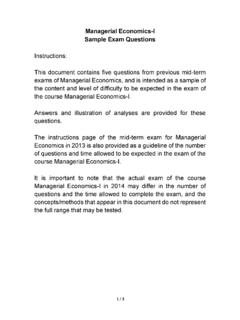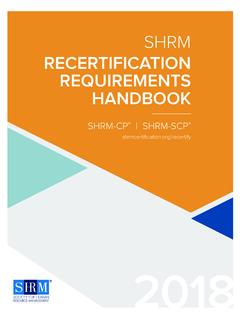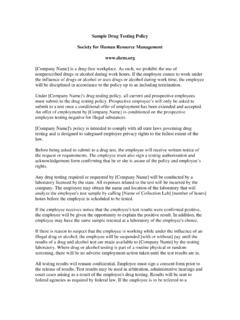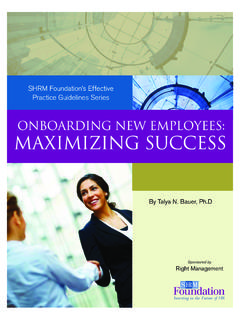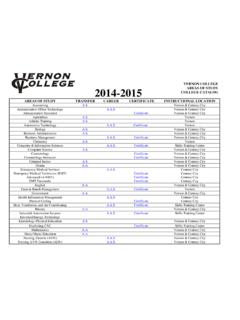Transcription of Strategic human resource management, firm …
1 Strategic human resource manage-ment (SHRM) is defined as the pat-tern of planned human resource de-ployments and activities intended toenable an organization to achieve itsgoals (Wright & McMahan, 1992, p. 298). Ithas been argued that when a firm s humanresource practices are consistent with eachother ( , internal fit), and with the firm sstrategic goals ( , external fit), organiza-tional efficiency and performance will beenhanced (Huselid, 1995; Wright & McMa-han, 1992). While SHRM is related to HR salignment with the firm s strategy, HR prac-tices are the exact mechanisms aimed at theacquisition, development, and motivationof human capital. In other words, SHRM fo-cuses on what a firm does with human re-sources, and HR practices refer to how these resources are the West, the conceptual and empir-ical link between SHRM and firm perform-ance has been well established in the liter-ature (Huselid, Jackson, & Schuler, 1997;Wright & Gardner, 2003).
2 Researchers haveshown that the use of Strategic HR prac-tices is positively related to both financialand operational performance (Delaney & Strategic human RESOURCEMANAGEMENT, FIRMPERFORMANCE, AND EMPLOYEERELATIONS CLIMATE IN CHINAHANG-YUE NGO, CHUNG-MING LAU, AND SHARON FOLEYWe examined Strategic human resource management (SHRM) and humanresource practices in the People s Republic of China to assess the impact ofthese practices on firm performance and the employee relations climate. Wealso tested whether firm ownership moderates the above relationships. Em-pirical results from a sample of Chinese firms from various industries and re-gions showed that the levels of adoption of SHRM and HR practices werelower in state-owned enterprises (SOEs) than in foreign-invested enterprises(FIEs) and privately owned enterprises (POEs).)
3 Both SHRM and HR practiceswere found to have direct and positive effects on financial performance, op-erational performance, and the employee relations climate. However, themoderating effect of ownership type was significant for financial perform-ance only . 2008 Wiley Periodicals, to: Hang-Yue Ngo, Department of management , Chinese University of Hong Kong, Shatin, NT,Hong Kong, Phone: (852) 2609-7797, E-mail: resource management ,Spring 2008, Vol. 47, No. 1, Pp. 73 90 2008 Wiley Periodicals, Inc. Published online in Wiley InterScience ( ). DOI: , Spring 2008 Huselid, 1996). Evidence also has been pro-vided of the synergistic effect of bundles ofHR practices on firm outcomes (Huselid,1995; MacDuffie, 1995). Although the applicability of SHRM andhigh-performance HR practices in Asia andhow they diverge or converge from the Westhave been examined, no conclusive resultshave been reached (Bae, Chen, Wan, Lawler,& Walumbwa, 2003; Von Glinow, Drost, &Teagarden, 2002).
4 Recently, several studiesconducted in China have found a positive re-lationship between SHRM and firm perform-ance (Bjorkman & Fan, 2002;Law, Tse, & Zhou, 2003).The present study attempts toextend the above line of researchby developing and testing a con-ceptual model of the HR perform-ance relationship in the contextof the People s Republic of differs from previous researchwork in the following ways. Firstof all, we investigate whetherSHRM and HR practices are re-lated to different firm outcomes,including financial performance,operational performance, and em-ployee relations climate. Em-ployee relations climate is viewedas an important aspect of organi-zational effectiveness (Schuster,1982, 1998) that has been under-researched.
5 Second, we test the moderat-ing effects of firm ownership onthe relationships between SHRM and HRpractices with firm outcomes. Firms of differ-ent ownership types, including state-ownedenterprises (SOEs), foreign-invested enter-prises (FIEs), and privately owned enterprises(POEs) face different institutional constraints(Ahlstrom & Bruton, 2001; Ding, Akhtar, &Ge, 2006) and they search for different HRmodels in order to operate effectively in theChinese transitional economy. Hence, theimpact of SHRM and HR practices on per-formance is likely to vary among these firms. Third, we surveyed both the CEO andone other top manager for their evaluationsof the effectiveness of the HR function intheir firm . In the existing literature, single-respondent measures of HR practices andfirm performance are often used eventhough these measures may contain signifi-cant amounts of measurement error (Ger-hart, Wright, McMahan, & Snell, 2000).
6 Inthis study, we collected information frommultiple respondents and thus avoided theissue of common method bias. Literature ReviewSHRM and HR PracticesAccording to the resource -based view (RBV),internal firm resources that are rare, valu-able, inimitable, and nonsubstitutable canprovide sources of sustainable competitiveadvantages (Barney, 1991). human resourcepractices that meet these criteria are such asource (Wright & McMahan, 1992) and thusenhance organizational performance. TheRBV has been instrumental in developingthe notion of SHRM, or the exploration ofHR s role in supporting business strategy(Wright, Dunford, & Snell, 2001). Devanna, Fombrum, Tichy, and Warren(1982) highlighted SHRM as a key process instrategy implementation.
7 Specifically, severaltypes of HR activities, such as performance ap-praisal, compensation, and development pro-grams, were considered as critical for strategyimplementation if they could elicit desiredemployee behaviors and enable managers toachieve long-term Strategic goals (Schuler &Jackson, 1999). Huselid (1995) conceptualizedSHRM as the emphasis each firm places onaligning its HR functions and competitivestrategy. Arguably, such an alignment (or ex-ternal fit) is conducive to firm performance(Bae & Lawler, 2000; Becker & Huselid, 1998).As suggested by Lado and Wilson (1994),a firm s HR practices also are a source of com-petitive advantage. HR practices generallyrefers to a set of internally consistent practicesadopted by firms to enhance the knowledge,skills, ability, and motivation of these practices support and develop thehuman resources and competencies, they addvalue to the firm (Wright, Smart, & McMa-han, 1995).
8 These practices, widely adoptedWhile SHRM isrelated to HR salignment with thefirm s strategy, HRpractices are theexact mechanismsaimed at theacquisition,development, andmotivation of resource ManagementDOI: human resource management , firm Performance, and Employee Relations75and utilized by large firms in Western coun-tries, are known as the mainstream (Lepak,Bartol, & Erhardt, 2005) or best HR practices(Wright & Gardner, 2003) in the practices often are viewed as bundles,rather than as isolated practices (MacDuffie,1995; Wright & McMahan, 1992). Internalconsistency is needed among them for ex-ample, extensive training should be comple-mented by compensation, performance ap-praisal, and promotion practices that reducestaff turnover in order to be effective (Baron &Kreps, 1999).
9 Considerable research evidenceexists supporting the relationship between in-ternally consistent HR practices and organiza-tional effectiveness (Becker & Huselid, 1998;Bowen & Ostroff, 2004; Huselid, 1995). HRM in ChinaBefore the economic reform, state-owned en-terprises had dominated the Chinese econ-omy. The operation and management of theSOEs were strongly influenced by traditionalculture and communist ideology. The Chineseculture has been marked by collectivism andConfucianism, with an emphasis on respectfor hierarchy, in-group harmony, reciprocity,and loyalty (Chen, 1995). These culture val-ues, together with tight bureaucratic controlfrom the government, shaped the pre-reformHRM system in the SOEs, which was charac-terized by lifelong job security, seniority-basedpromotion and wage increases, and extensivewelfare programs (Warner, 1996; Yu & Egri,2005).
10 The so-called iron rice bowl employ-ment system that emphasized egalitarianismand workforce stability, however, has beencriticized as incompatible with the new eco-nomic reforms in HRM have beenlaunched since the 1990s, with the primaryobjective of enhancing efficiency and pro-ductivity in SOEs. Major changes includedthe introduction of fixed-term employmentcontracts and performance-based rewards, ashift in welfare provision responsibility, and anew labor law regulating employment rela-tions (Warner, 1996). Additionally, employ-ment policies and practices have been decen-tralized to the enterprise level, and managersin SOEs have been granted greater autonomyin hiring and firing workers (Chow, Fung, &Ngo, 1999). In effect, the iron rice bowl employment system has been abolished.
